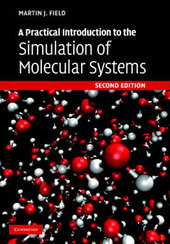
|
A Practical Introduction to the Simulation of Molecular Systems
Hardback
Main Details
| Title |
A Practical Introduction to the Simulation of Molecular Systems
|
| Authors and Contributors |
By (author) Martin J. Field
|
| Physical Properties |
| Format:Hardback | | Pages:344 | | Dimensions(mm): Height 255,Width 180 |
|
| Category/Genre | Atomic and molecular physics
3D graphics and modelling |
|---|
| ISBN/Barcode |
9780521852524
|
| Classifications | Dewey:541.220113 |
|---|
| Audience | | Professional & Vocational | |
|---|
| Edition |
2nd Revised edition
|
| Illustrations |
Worked examples or Exercises
|
|
Publishing Details |
| Publisher |
Cambridge University Press
|
| Imprint |
Cambridge University Press
|
| Publication Date |
19 July 2007 |
| Publication Country |
United Kingdom
|
Description
Molecular simulation is a powerful tool in materials science, physics, chemistry and biomolecular fields. This updated edition provides a pragmatic introduction to a wide range of techniques for the simulation of molecular systems at the atomic level. The first part concentrates on methods for calculating the potential energy of a molecular system, with new chapters on quantum chemical, molecular mechanical and hybrid potential techniques. The second part describes methods examining conformational, dynamical and thermodynamical properties of systems, covering techniques including geometry-optimization, normal-mode analysis, molecular dynamics, and Monte Carlo simulation. Using Python, the second edition includes numerous examples and program modules for each simulation technique, allowing the reader to perform the calculations and appreciate the inherent difficulties involved in each. This is a valuable resource for researchers and graduate students wanting to know how to use atomic-scale molecular simulations. Supplementary material, including the program library and technical information, available through www.cambridge.org/9780521852524.
Author Biography
Martin J. Field is Group Leader of the Laboratoire de Dynamique Moleculaire at the Institut de Biologie Structurale - Jean-Pierre Ebel, Grenoble. He was awarded his PhD in quantum chemistry from the University of Manchester, UK, in 1985. His areas of research include using molecular modeling and simulation techniques to study biological problems more specifically, his current interests are in the development and application of hybrid potential techniques to study enzymatic reaction mechanisms and other condensed phase processes.
ReviewsReview of the first edition: 'This text straddles the boundary between theory and experiment ... Martin Field's book is aimed at the novice user who is likely to be a graduate student or researcher in computational chemistry or biophysics. The provision of example programs ensures that readers should achieve a reasonable understanding of how simulations are performed and how the programs work ... This book is likely to spend much time sitting next to the mouse by a terminal.' The Times Higher Education Supplement Review of the first edition: ' ... this textbook is presented in an interesting style and is quite readable, even for relative newcomers to this field. It is certainly an appropriate book for the advanced undergraduate or graduate course level, and will be a valuable teaching aid for those presenting this topic. It should be of interest not only to the physical chemist, but also to those involved in computational biophysics, biochemistry or molecular physics.' Scientific Computing World Review of the first edition: 'The book is a good introduction to simulation. It is suitable for university course work, including computer practicals ... as well as for training company employees new to molecular simulation.' Florian Muller-Plathe, Angewandte Chemie Review of the first edition: 'The book should be particularly useful to all active practitioners in molecular simulation techniques, chiefly graduate students and researchers in universities and industry ... this book is a valuable addition to my shelf and one that I must make sure doesn't disappear because my research group has taken off with it!' Neil L. Allan, Chemistry and Industry
|